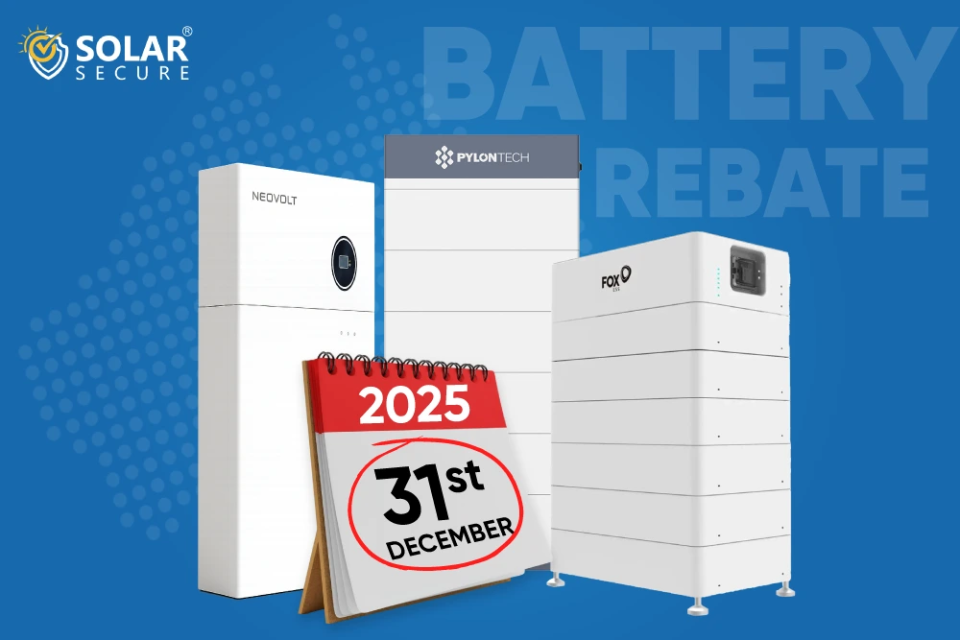The Australian Government’s national battery discount (the Cheaper Home Batteries Program, delivered through the SRES) launched in 2025 and initially gives households ~30% off the upfront cost of eligible small-scale batteries. That discount is designed to decline each year until 2030, so the relative subsidy available for batteries purchased after the end of 2025 will be smaller than the initial 2025 level. This affects how much you save up front, how quickly a battery pays back, and how state + federal offers stack together.
Quick facts you should know
- Program name: Cheaper Home Batteries Program, run through the Small-scale Renewable Energy Scheme (SRES). It started in 2025 (practical delivery began 1 July 2025).
- Typical headline value (2025): About 30% off the installed cost, often expressed as a per-usable-kWh reduction (market commentary has been using ~$350–$375 per usable kWh as a working figure).
- Critical: The discount is phased down annually until the scheme ends in 2030, the subsidy level in 2026, 2027 etc. will be lower than 2025. Government pages and program docs make the decline explicit.
How the rebate actually works (simple explanation)
The government made batteries eligible under the existing SRES framework. Instead of a cashback after you buy, the discount is normally applied at point of sale through the installer/retailer, effectively reducing the installed price by an amount tied to each kilowatt-hour of usable battery capacity (calculated using Small-scale Technology Certificates, STCs, and their valuation mechanism). Over time the number of STCs per kWh allocated to batteries is reduced, so the dollar discount declines.
Timeline and the “decrease after Dec 2025” claim - what’s actually happening
- The program’s generous initial rate applied from the program’s start in 2025 (public rollout from 1 July 2025).
- The legislation/regulatory settings lock in a declining schedule of STC (or STC-equivalent) support between 2026 and 2030 so each successive year the per-kWh subsidy is smaller. Headlines and government pages say the discount will “gradually decrease until 2030.”
- Example industry figures used publicly: The 2025 allocation of 9.3 STCs per usable kWh (a 30%ish discount in practice) falling to 4.7 STCs per usable kWh by 2030, emphasising a materially lower rebate later in the decade. (Note: the dollar value of an STC is a market price and can move, so final dollar rebates depend on that market.)
Why the rebate decreases - policy rationale
Governments often design uptake-support schemes to be largest at the start (to jump-start demand and drive scaling of supply chains), then taper support as industry costs fall and market maturity grows. The Cheaper Home Batteries Program follows that pattern: front-loading the subsidy to rapidly boost installations, then tapering to reflect expected cost reductions and to target limited public funds efficiently. The regulatory STC schedule formalises that taper.
How to evaluate whether to buy now or later (practical checklist)
1. Get multiple quotes - Compare installed price, brand, usable capacity (kWh), round-trip efficiency, warranty terms and the installer’s track record. Don’t compare headline kWh alone.
2. Ask how the federal discount is applied - Point-of-sale discount vs. other delivery mechanisms; confirm the net price you’ll pay.
3. Add up stacking opportunities - State rebates (e.g., WA programs), financing offers, VPP credits — sometimes state + federal can materially improve economics. But check terms closely.
4. Don’t chase the cheapest product - Dodgy installs and poor-quality batteries can lead to safety, performance and warranty failures. Independent reviews and local installer references are invaluable. The rollout has already attracted aggressive offers, so be cautious.
Common misconceptions
“The rebate will vanish overnight.” No — the program is explicitly phased down to 2030, not abruptly cut at the end of 2025. But the most generous 2025-level support is finite and higher than later years.
“The rebate guarantees huge lifetime savings.” Upfront subsidy helps economics, but lifetime savings depend on battery sizing, electricity prices, solar generation, degradation and whether you participate in VPPs or demand-response programs.
Federal Battery Rebate Declines Each Year
| Year | STCs per kWh | Estimated Value per kWh (based on $40/STC) |
|---|---|---|
| 2025 | 9.3 | $372 |
| 2026 | 8.4 | $336 |
| 2027 | 7.4 | $296 |
| 2028 | 6.5 | $260 |
| 2029 | 5.6 | $224 |
| 2030 | 4.7 | $188 |
The estimated value per kWh is approximate and based on $40 per STC for a battery installed in the year. This could vary over time in line with reviews of whether the discount remains appropriate.
Your Step-by-Step Guide to Claiming the Rebate
1. Check your eligibility:
Already have solar or a battery? No problem, just ensure your previous battery didn’t receive the federal rebate. Your system must be grid-connected and use an approved battery brand.
2. Request a compliant quote:
Get in touch with Solar Secure or another accredited retailer. We’ll inspect your setup, advise on suitable battery brands, and provide a rebate-compliant quote.
3. Secure your rebate allocation:
Your installer applies through the official rebate portal and reserves your rebate, and this must be done before installation is certified.
4. Install and certify after July 1:
Work with a professional team who understands the rebate rules. Solar Secure ensures the Certificate of Electrical Compliance is dated correctly, and that all documentation, including geotagged photos is collected.
5. VPP-ready setup:
If you’re joining a VPP, we’ll configure your battery accordingly and help you understand how to track earnings and performance.
6. Enjoy the savings:
The rebate is applied as a discount on your invoice. You pay less upfront, and your battery starts delivering value from day one.
Bottom line (actionable takeaways)
- The federal battery rebate is available now at its most generous level (2025) but is designed to decline each year through to 2030. This means buyers later in the program will typically get a smaller federal discount.
- If you’re actively exploring a battery install, balance timing (higher 2025 rebate) against quality (don’t sacrifice a good installer or warranty for a marginal price cut). Use multiple quotes, confirm how discounts are applied, and check stacking with state programs.





